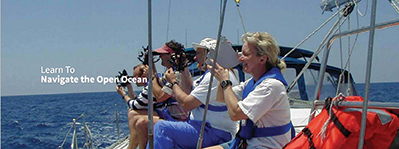Learning to sail is one of life’s great rewards and choosing the right school and the right progression of courses makes all the difference in the world (published August 2017)
Before Rosie and I took off sailing around the world, she thought it would be prudent for her to take some sailing and cruising lessons on her own so she could learn from someone other than her husband the tricks and skills of managing a cruising boat on her own. We had been sailing together for 15 years and had cruised extensively. But, she was never the captain and the decision maker and now that we had a long voyage ahead of us, she wanted to know she could do it.
She signed up for a week of sailing lessons in our home port of Newport, RI and she went through an intermediate level course with flying colors. She discovered she knew a lot more than she thought she did, is how she put it at the week’s end.
Next, she headed off to the B.V.I. for a week-long learn to cruise course on a larger cruising boat. She had to do everything on the boat from reeving sails, hoisting a dinghy on deck and tying in reefs, to navigation and radio skills. She mastered anchoring on her own, docking and close quarter maneuvers under power and much more. When she got home, her hands were sailor-hard, she was nut brown and she knew she was on the road to sailing independence.

But Rosie hankered for one more experience and that was an offshore passage sans husband. A friend of ours from Connecticut was running a small “get offshore experience” business aboard his 40-foot sloop. He would take a crew of four paying customers from Long Island Sound to Bermuda and teach them pasagemaking skills along the way.
Rosie signed up and on a very blustery spring day headed off to sea. The four-day trip to Bermuda was rough to start and very rough in the Gulf Stream. Then, the wind moderated and they had a fine sail to St. George’s, Bermuda. Along the way, she learned a lot of hands-on skills in challenging conditions and found that standing watches and managing the boat at night were well within her capabilities. She encountered really big seas in the Gulf Stream and managed okay but, to this day, that is the one thing about offshore sailing that gives her pause.
In the fall of that year, we climbed aboard our Mason 43 Clover and headed off with our sons Si and Tim on a family adventure that would take us around the world in a westabout circumnavigation via Panama and Suez. With all of the training Rosie had undertaken before we left, she sailed as an equal partner and as a very competent and capable offshore sailor. And, a great shipmate.
 GETTING STARTED
GETTING STARTED
Even if you have some sailing experience, taking a series of courses at an accredited sailing school is not only a great way to build a foundation of skills, it can also be a really fun way to have a sailing vacation as a couple or a family.
The two organizations that certify sailing schools and provide standardized curriculae are US Sailing and the American Sailing Association (ASA). The larger sailing schools and programs such as Colgate’s Offshore Sailing School and J/World, use the US Sailing program while the majority of smaller schools and those run by yacht dealers and charter companies tend to use the ASA program. The US Sailing program is maintained by the non-profit governing association for sailing in the U.S. while the ASA program is a straight for-profit business.
Both programs offer a series of courses designed to take you from the total landlubber stage right through advanced cruising and racing skills. If you have the time, you could conceivably go through a complete series of courses in the span of a summer but most new sailors take it more slowly and go as far as they feel they need to be comfortable on their own boat.
Charter certification is a useful ticket to have if you plan to charter in Europe where many countries require charter skippers to demonstrate that they have passed a sanctioned course. Both US Sailing and ASA offer courses and certificates that fulfill this requirement.
 LEARN TO CRUISE
LEARN TO CRUISE
As Rosie discovered, sailing in the smaller boats of a local sailing school, often boats like J/22s, Sonars, or the Colgate 26, helps you get accustomed to the interaction between the wind, the sails, the boat and the water in a very immediate way. If the boat is heeling too much, you know it up close and in your face. If the boat sails into irons, it is perfectly obvious that you have stopped.
But most BWS readers and the cruising community sail in much larger boats, often in the 40-foot and up range. In boats of this size, everything is heavier and most maneuvers happen more slowly than in smaller boats. So, once you have mastered sailing essentials it is time to move on to courses held in cruising boats. Many schools will offer this level of course or you may choose to fly to a special destination and make the course a vacation in the B.V.I, U.S.V.I. or Florida.
















